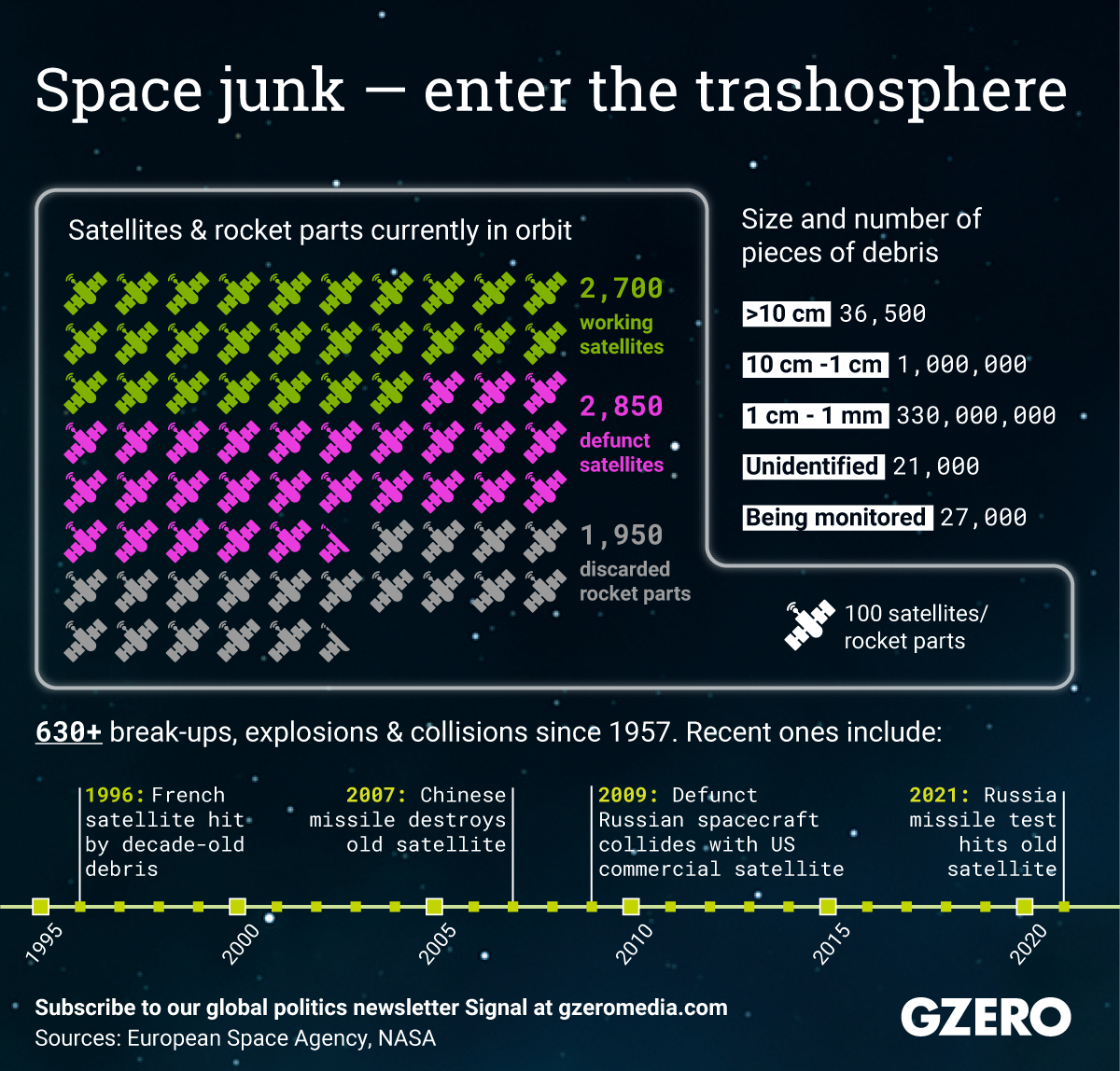November 16, 2021
A Russian missile shot down on Monday a Soviet-era defunct satellite, breaking it up into thousands of fragments and throwing NASA into a tizzy. As the number of satellites in space has grown rapidly in recent years, the amount of trash floating up there too now vastly exceeds the tonnage of the satellites themselves from accidents, collisions, explosions, and the odd missile hit. It's not just a litter problem — space junk moves at over 17 thousand miles per hour, as fast as functioning spacecraft, so even a tiny fragment can severely damage a satellite. We compare the number of satellites to the debris circling Earth.
From Your Site Articles
- War in space? Time to update space law - GZERO Media ›
- Mission to the Moon, with Artemis II astronaut Jeremy Hansen - GZERO Media ›
- The satellite revolution in Low Earth Orbit - GZERO Media ›
- The future of space: congested and contested - GZERO Media ›
- Can the US stay ahead of Russia & China in the space race? - GZERO Media ›
- Mark Kelly on the new space race - GZERO Media ›
More For You
French President Emmanuel Macron, German Chancellor Friedrich Merz, Ukrainian President Volodymyr Zelenskiy, U.S. Special Envoy Steve Witkoff and businessman Jared Kushner, along with NATO Secretary-General Mark Rutte and otherEuropean leaders, pose for a group photo at the Chancellery in Berlin, Germany, December 15, 2025.
Kay Nietfeld/Pool via REUTERS
The European Union just pulled off something that, a year ago, seemed politically impossible: it froze $247 billion in Russian central bank assets indefinitely, stripping the Kremlin of one of its most reliable pressure points.
Most Popular
Sponsored posts
Consumers are spending–just not evenly
What's Good Wednesdays
What’s Good Wednesdays™, December 17, 2025 – holiday movie edition
Walmart’s $350 billion commitment to American manufacturing means two-thirds of the products we buy come straight from our backyard to yours. From New Jersey hot sauce to grills made in Tennessee, Walmart is stocking the shelves with products rooted in local communities. The impact? Over 750,000 American jobs - putting more people to work and keeping communities strong. Learn more here.
Of all the threats to the world, what are the top 10 most urgent global risks for 2026? On Monday, January 5, at 12 pm ET, join us for a livestream discussion with Ian Bremmer and global experts to discuss the Top Risks of 2025 report from Eurasia Group. This report will mark twenty years of Ian Bremmer’s annual forecast of the political risks that are most likely to play out over the year. Event link: gzeromedia.com/toprisks
In this episode of Tools and Weapons, Microsoft Vice Chair and President Brad Smith sits down with Ed Policy, President and CEO of the Green Bay Packers, to discuss how purpose-driven leadership and innovation are shaping the future of one of the world’s most iconic sports franchises. Ed shares how technology and community-focused initiatives, from Titletown Tech to health and safety innovations on the field, are transforming not just the game of football, but the economy and culture of Green Bay itself. He explains how combining strategic vision with investment in local startups is keeping talent in the Midwest and creating opportunities that extend far beyond Lambeau Field.
Subscribe and find new episodes monthly, wherever you listen to podcasts.
© 2025 GZERO Media. All Rights Reserved | A Eurasia Group media company.
